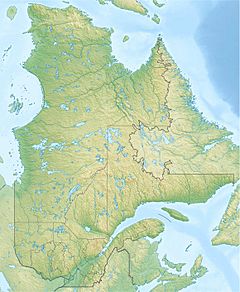Tortue River (L'Islet) facts for kids
Quick facts for kids Tortue River |
|
|---|---|
| Native name | Rivière Tortue |
| Country | Canada |
| Province | Quebec |
| Region | Chaudière-Appalaches |
| MRC | L'Islet Regional County Municipality |
| Physical characteristics | |
| Main source | Forest stream Saint-Aubert 144 metres (472 ft) 47°07′11″N 70°15′50″W / 47.11974725°N 70.26402715°W |
| River mouth | St. Lawrence River L'Islet 4 metres (13 ft) 47°08′56″N 70°20′23″W / 47.14889°N 70.33972°W |
| Length | 11.0 kilometres (6.8 mi) |
| Basin features | |
| Tributaries |
|
The Tortue River (in French: rivière Tortue) is a small river located in the Quebec province of Canada. It flows into the mighty Saint Lawrence River, which is one of the biggest rivers in North America. The Tortue River is found on the south side of the St. Lawrence, near a village called L'Islet-sur-Mer.
About the Tortue River
The Tortue River is not very long, only about 11 kilometers (which is about 6.8 miles) from where it starts to where it ends. It begins as a small forest stream in a place called Saint-Aubert. From there, it makes its way through the land until it reaches the much larger St. Lawrence River.
Where Does It Flow?
The river's journey starts in the Chaudière-Appalaches region of Quebec. This region is known for its beautiful landscapes. The Tortue River flows through the L'Islet Regional County Municipality, which is a local area in Quebec.
When it reaches the end of its path, the Tortue River empties into the St. Lawrence River. This happens near the village of L'Islet, which is right on the coast. The St. Lawrence River is a very important waterway for Canada.
What's in a Name?
The name Rivière Tortue means "Turtle River" in French. Rivers are often named after things found in the area or how they look. It's possible that this river was named because of turtles living there a long time ago. It could also be because the river flows slowly, like a turtle, or because its path looks like a turtle's shell.
The official name, Rivière Tortue, was made official on December 5, 1968. This was done by the Commission de toponymie du Québec, which is a group in Quebec that decides and keeps track of place names.


